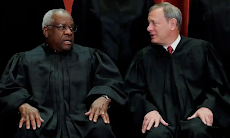Palin was right that any kind of healthcare rationing runs the risk of this kind of calculus, where we weight spending $10,000 to extend a young, healthy person's life by 40 years against $1,000 to extend an elderly, disabled person's life by a mere two years.
It's a ghastly, nightmarish prospect – as anyone who uses the private healthcare system knows very well. More than 27m Americans have no health insurance, and millions more have been tricked into buying scam "cost-sharing" systems run by evangelical grifters:
https://www.nytimes.com/2020/01/02/health/christian-health-care-insurance.html
But for the millions of Americans with insurance, death panels are an everyday occurrence, or at least a lurking concern. Anyone who pays attention knows that insurers have entire departments designed to mass-reject legitimate claims and stall patients who demand that the insurer lives up to its claim:
The private healthcare sector is designed to deny care. Its first duty is to its shareholders, not its patients, and every dollar spent on care is a dollar not available for dividends. The ideal insurance customer pays their premiums without complaint, and then pays cash for all their care on top of it.
All that was true even before private equity started buying up and merging whole swathes of the US healthcare system (or "healthcare" "system"). The PE playbook – slash wages, sell off physical plant, slash wages, reduce quality and raise prices – works in part because of its scale. These aren't the usual economies of scale. Rather the PE strategy is to buy and merge all the similar businesses in a region, so customers, suppliers and workers have nowhere else to turn.
That's bad enough when it's aimed at funeral homes, pet groomers or any of the other sectors that have been bigfooted by PE: (...)
But it's especially grave when applied to hospitals: (...)
Or emergency room physicians: (...)
And if you think that's a capitalist hellscape nightmare, just imagine how PE deals with dying, elderly people. Yes, PE has transformed the hospice industry, and it's even worse than you imagine.
Yesterday, the Center for Economic and Policy Research published "Preying on the Dying: Private Equity Gets Rich in Hospice Care," written by some of the nation's most valiant PE slayers: Eileen Appelbaum, Rosemary Batt and Emma Curchin: (...)
Medicare pays private hospices $203-$1,462 per day to take care of dying old people – seniors that a doctor has certified to have less than six months left. That comes to $22.4b/year in public transfers to private hospices. If hospices that $1,462 day-rate, they have lots of duties, like providing eight hours' worth of home care. But if the hospice is content to take the $203/day rate, they are not required to do anything. Literally. It's just free money for whatever the operator feels like doing for a dying elderly person, including doing nothing at all.
As Appelbaum told Maureen Tkacik for her excellent writeup in The American Prospect: "Why anybody commits fraud is a mystery to me, because you can make so much money playing within the guidelines the way the payment scheme operates."
In California, it's very, very easy to set up a hospice. Pay $3,000, fill in some paperwork (or don't – no one checks it, ever), and you're ready to start caring for beloved parents, grandparents, sisters, brothers, aunts and uncles as they depart this world. You do get a site inspection, but don't worry – you aren't required to bring your site up to code until after you're licensed, and again, they never check – not even if there are multiple complaints. After all, no one at the Centers for Medicare & Medicaid Services (CMS) has the job of tracking complaints.
This is absolute catnip for private equity – free government money, no obligations, no enforcement, and the people you harm are literally dying and can't complain. What's not to like? No wonder PE companies have spent billions "rolling up" hospices across the country. There are 591 hospices in Van Nuys, CA alone – but at least 30 of them share a single medical director: (...)
Medicare caps per-patient dispersals at $32,000, which presents an interesting commercial question for remorseless, paperclip-maximizing, grandparent-devouring private equity ghouls: do you take in sick patients (who cost more, but die sooner) or healthy patients (cost less, potentially live longer)?
In Van Nuys, the strategy is to bring in healthy patients and do nothing. 51% of Van Nuys hospice patients are "live discharged" – that is, they don't die. This figure – triple the national average – is "a reliable sign of fraud."
There are so many hospice scams and most of them are so stupid that it takes a monumental failure of oversight not to catch and prevent them. Here's a goodun: hospices bribe doctors to "admit" patients to a hospice without their knowledge. The hospice bills for the patient, but otherwise has no contact with them. This can go on for a long time, until the patient tries to visit the doctor and discovers that their Medicare has been canceled (you lose your Medicare once you go into hospice).
Another scam: offer patients the loosest narcotics policy in town, promising all the opioids they want. Then, once their benefits expire, let them die of an overdose (don't worry, people who die in hospice don't get autopsies):
https://www.newyorker.com/magazine/2022/12/05/how-hospice-became-a-for-profit-hustle
You can hire con artists to serve as your sales-force, and have them talk vulnerable, elderly people into enrolling in hospice care by convincing them they have nothing to live for and should just die already and not burden their loved ones any longer.
Hospitals and hospices also collude: hospitals can revive dying patients, ignoring their Do Not Resuscitate orders, so they can be transfered to a hospice and die there, saving the hospital from adding another dead patient to their stats.
CMS's solution is perverse: they're working with Humana to expand Medicare Advantage (a scam that convinces patients to give up Medicare and enrol in a private insurance program, whose private-sector death panel rejects 13% of claims that Medicare would have paid for). The program will pay private companies $32,000 for every patient who agrees to cease care and die. As our friends on the right like to say, "incentives matter."
by Cory Doctorow, Pleuralistic | Read more:
Image: Seydelmann, CC BY-SA 3.0, modified
[ed. What good hospice care looks like: President Jimmy Carter and the benefits of early hospice care (Seattle Times). Then, there's this: Born to Die (American Prospect); and, How Hospice Became a For-Profit Hustle (New Yorker).]



















